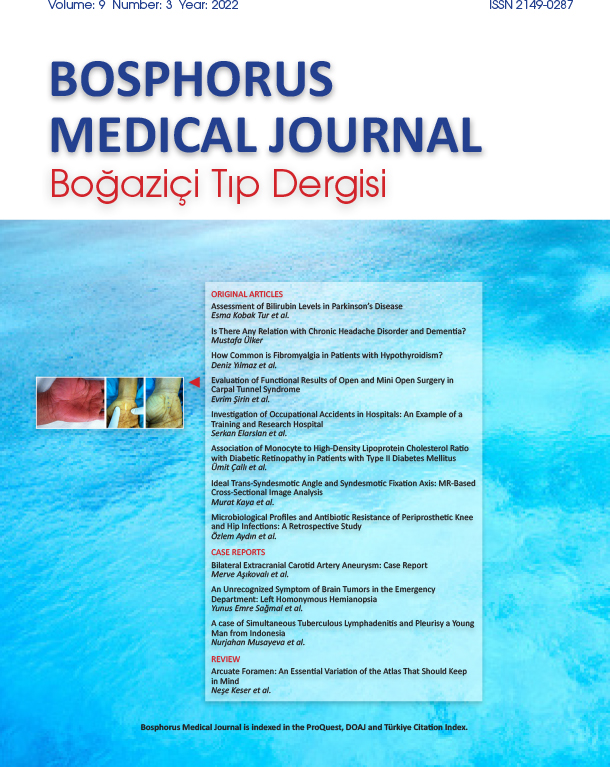Volume: 5 Issue: 3 - 2018
| ORIGINAL RESEARCH | |
| 1. | First Year Evaluation of Negative Cervical Conizations Performed for Various Reasons in A Tertiary Center Taner Günay, Oğuz Devrim Yardımcı, Meryem Hocaoğlu, Kemal Sandal, Hatice Şelendir doi: 10.15659/bogazicitip.19.01.937 Pages 77 - 80 Aim: We aimed in current study to identify the frequency of abnormal cytology, human papilloma virus (HPV) status and their clinical significance in patients with negative conization results performed for various reasons. Materials and Method: We evaluated the pathologic results of cold knife conization and loop electrosurgical excision procedures (LEEP) performed for 317 patients in our institution in between January 2010 and January 2017. We studied 56 patients with negative conization after excluding 261 patients with preinvasive or invasive results. We compared their cytologic and HPV status before excisional procedure with 12th month results and discussed its clinical significance. Results: The histopathologic evaluation results of negative conization performed for various indications were as follows: Chronic servisitis: 34/56 (60.7%), immature squamous metaplasia: 6/56 (10.7%), normal transformation zone: 5/56 (8.9%), wide cautery artifact: 4/56 (7.1%), foreign body reaction: 3/56 (5.3%), normal ectocervical epithelium: 2/56 (3.5%), atrophic findings: 2/56 (3.5%). For 39 patients with a known human papilloma virus deoxyribonucleic acid (HPV DNA) status, preconizational HPV positivity and negativity was 27/39 (69.2%) and 12/39 (30.7%) respectively. HPV status of 17 (30.4%) patients had not been known before conization. In the 12th month following conization, HPV positivity for 46 patients with a known HPV status was 9/46 (19.5%) and negativity was 37/46 (75.5%). HPV status for 10 (17.9%) patients was not known. Seven of nine patients who had positive HPV in postconization follow-up had positive HPV results before conization, too. Preconization HPV status of three patients had not been determined. Seven of 27 preconizational HPV positive patient was HPV positive in the first year of follow-up. With excisional procedure a clearance with a rate of 20/27 (74.1%) was rendered. For two patients with preexcisional positivity, the HPV DNA results were not found. For eight of 50 patients in follow-up group the cytologic results were as follows: high grade squamous intraepithelial lesion (HSIL): 4, low grade intraepithelial lesion (LSIL): 1, atypical squamous cells of undetermined significance (ASCUS): 2, atypical glandular cells (AGC): 1. Conclusion: Althought the diagnosis of cervical preinvasive disease can be done with biopsy samplings, some histopathologic evaluations for excisional procedures like conization or LEEP will reveal will a negative result for preinvasive or invasive disease. But, HPV positivity and abnormal cytologic results has not been reported uncommon in such groups. In the light of this data, we can reduce the undesirable clinical results after a negative conization result with a thorough follow-up. |
| 2. | Magnesium Levels in Acute Ischemic Stroke Mustafa Eser, Eren Gözke, Işıl Kalyoncu Aslan, Pelin Doğan Ak doi: 10.15659/bogazicitip.19.01.941 Pages 81 - 83 Objective: Acute ischemic stroke (AIS) is a syndrome which manifests itself as a result of thromboembolic occlusions of cerebral arteries where signs and symptoms related to the affected region rapidly settle. In this study the impact of magnesium as a risk factor in AIS has been investigated. Material and Methods: Two hundred and twenty-one patients diagnosed as AIS, and 157 individuals without cerebrovascular disease were evaluated. Blood magnesium levels of the patients were measured within the first 24 hours after onset of stroke, and compared with those of the control group. Besides, in all cases, any correlation of blood magnesium levels with the presence of hypertension, diabetes mellitus (DM), coronary artery disease (CAD), and location of infarct according to Banford scale (total anterior, partial anterior, posterior, and lacunar) were investigated. Results: A significant difference was not found between two groups as for mean age of the groups, and distribution of genders (AIS group: 73.0 ± 13.7 years; 99 women, 122 men vs control group: 71.5 ± 10.1; 68 women, and 89 men). A significant difference was not detected between the groups as for average blood magnesium levels (AIS group: 1.90 ± 0.25mg/dl; control group: 1.91 ± 0.20mg/dl, p>0.05). Magnesium levels were within normal limits in all groups. In the AIS group mean magnesium levels did not differ significantly with respect to the presence of hypertension, DM, and CAD (p>0.05). Blood magnesium levels did not differ according to the location of the infarct areas (p>0.05). Conclusions: This study indicates that in cases with AIS, magnesium level is not a risk factor, and it is not related to major risk factors, and location of infarct. |
| 3. | Acute Phase Reactants as Inflammation Indicator in Acute Ischemic Stroke Aybala Neslihan Alagöz, Şerefnur Öztürk, Şenay Özbakır doi: 10.15659/bogazicitip.19.01.973 Pages 84 - 91 INTRODUCTION: Aim: The studies about the pathogenesis of stroke have been intensified especially over the inflammation theory recently. In this study, the relation between the acute phase reactans; C Reactive Protein (CRP), fibrinogen, leukocyte count and the other risk factors for stroke and time dependent changes as a prognostic factor were investigated in order to find out the role of the acute inflammation as arisk and prognostic factor in the stroke patients. METHODS: Materials and Method: Twenty-two female and twenty-eight male patients (total 50) who were diagnosed as acute stroke were included in the study. The control group was consisted of 30 individuals. The level of the CRP, fibrinogen and leukocyte counts were studied on the first 3 days and on the 7th day. RESULTS: Results: The CRP level studied on the 7th day of stroke was significantly different from the control group (p=0.045). On the 7th day fibrinogen level showed significant decrease in the patient group (p=0.04).On the first and 7th days, the leukocyte count was found to be higher than that of the control group at the same level of significance (p=0.0, 0.0). In the paired sample; On the first and 7th days, CRP, fibrinogen and leukocyte levels were evident with a significant 7th day increase in CRP.First day Rankin scores with firstdays CRP (p = 0.025) and leucocyte count (p = 0.010);7th day Rankin scores withfirst day CRP (p = 0,026), 7th day CRP (p = 0.025), first day fibrinogen (p = 0.048) and leukocyte count (p = 0.015), 7th day NIHSS with first day CRP levels (p = 0.022) showed a significant positive correlation DISCUSSION AND CONCLUSION: Conclusion: Determination of the presence of immunopathogenesis in stroke patients; as a prognostic marker in clinical practice, is important in that it leads to the use of acute phase reactants, as well as to preventive and curative treatment methods that can be developed in the future. |
| 4. | Mi̇ddle and Long-Term Results of Repai̇r of Acute Achi̇lles Tendon Ruptures wi̇th Early Open Pri̇mary Modi̇fi̇ed Kessler Method Barış Yılmaz, Cem Çopuroğlu, Mert Özcan, Mert Çiftdemir, Erol Yalnız doi: 10.15659/bogazicitip.19.01.999 Pages 92 - 96 INTRODUCTION: Aim: The aim of this study was to evaluate the middle and long-term results of repair of acute Achilles tendon ruptuers with early open primary modified Kessler method. METHODS: Materials and Method: Thirty-one patients who underwent surgical treatment with open primary modified Kessler method for the treatment of acute Achilles tendon rupture in the early period (1-3) days with regular follow-up of more than 36 months were included in the study. AOFAS and Thermann et al. Scoring systems were used in the evaluation of the results. RESULTS: Results: All of the patients were male and the mean age was 33.6 (19-55). Average 1.27 (1-3) days treated with open primary modified Kessler method and the mean follow-up period was 87.2 months (37-151). The mean AOFAS score of the cases was 91.96 (range 82 to 100). The mean score of Thermann et al. Achilles tendon postoperative evaluation score was 94.5. There was no recurrent tear or tendon adherence to the skin. Only one patient developed superficial skin necrosis on the 4th day, with wound debridement and secondary suture the patient recovered. DISCUSSION AND CONCLUSION: Conclusion: Acute Achilles tendon ruptures, especially early in the treatment of primary open modified Kessler method with middle and long-term results, it is observed that is extremely successful. |
| CASE REPORT | |
| 5. | A Polymyalgi̇a Rheumati̇ca Case Di̇agnosed wi̇th Ultrasonography Findings Berrak Taş, Feyza Ünlü Özkan, Pınar Akpınar, İlknur Aktaş doi: 10.15659/bogazicitip.19.01.988 Pages 97 - 99 Polymyalgia rheumatica (PMR) is a chronic inflammatory disease characterized by shoulder and pelvic girdle pain, morning stiffness in older age group. The association with giant cell arteritis (DHA) is frequent. in an elderly patient with proximal muscle pain, morning stiffness, elevated erythrocyte sedimentation rate (ESR) PMR should be kept in mind. In the update made in 2012, the specificity of criterias is increased by adding ultrasonographic (USG) findings to the classification criteria of PMR. Here we present a case of PMR diagnosis in consideration of USG findings. |
| 6. | Creutzfeldt Jacob Di̇sease Presenti̇ng wi̇th Paraparesi̇s: A Case Report Hatice Ferhan Kömürcü, Pınar Akyüz Öztürk, Ayşe Nur Özcan, Karabekir Ercan, Ömer Anlar Pages 100 - 102 Creutzfeldt's Jacob Disease (CJD) is a rare, rapidly progressive, usually fatal neurodegenerative disease that may be caused by a prion protein and transmittable. Patients may present with different clinical features. We report here a 68-year-old man who was admitted to neurology clinic with paraparesis, diagnosed CJD and died within 1 month after diagnosis. |
| 7. | Ultrasonography Usage in Heterotopic Ossification: Case Report Ezgi Kaya, Aslıhan Taraktaş, Özge Gülsüm İlleez, Feyza Ünlü Özkan, İlknur Aktaş doi: 10.15659/bogazicitip.19.01.879 Pages 103 - 106 Heterotopic ossification (HO) is defined as bone formation in an abnormal anatomic region, usually soft tissue. HO may develop after neurological diseases (such as traumatic brain injury, spinal cord injury) or trauma. In early disease, temperature increase, swelling, erythema and decreased joint movement are typically seen. It can be confused with deep vein thrombosis and infection. Findings of diagnostic radiography may appear about 1 month after the onset of symptoms. Ultrasonography (USG) has been reported to be useful in early detection and follow-up of HO. Here, the importance of USG in the early diagnosis of HO following trauma is indicated. |




















